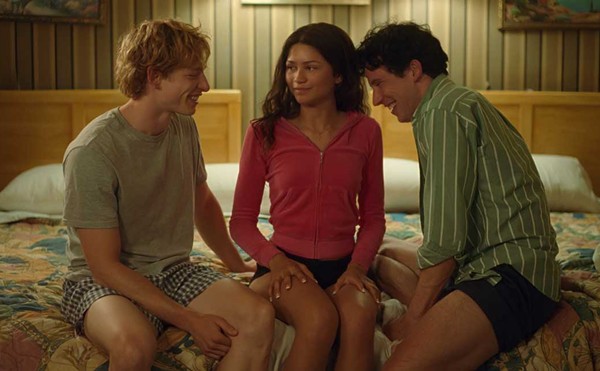Rushing to yoga class for a deep dose of serenity, which usually wears off on the drive home, is what many women do to center their hectic lives. Would you like to meet, in a way, a woman preternaturally centered, effortlessly grounded? You can at CCS' Center Galleries, in the exhibit Ann Mikolowski: Two Ways of Looking in a Mirror. A Detroit painter, wife, mother and working woman, Mikolowski's sense of comfort in her own skin permeates this gorgeous, calming installation by gallery director Michelle Perron.
Mikolowski died of breast cancer in 1999, but her reputation as a beloved friend to intellectual, avant-garde and plain, average people, lives on in legend. In Detroit, with her husband Ken, she founded the Alternative Press, publishing the work of such iconic poets as Allen Ginsberg and other gifted, albeit not-so-famous, writers. Everyone became "family."
This show vividly illustrates a life of panache and grace. It's a tribute to Mikolowski's natural empathy for people and places, displaying the two sides — the yin and the yang — of her (some say critically neglected) life's work in art. With equal aplomb, Mikolowski represents a cacophonous social world in her portraits and the silence of the natural world in her unpeopled landscapes, many of Lake Huron near her home in Michigan's thumb. This dichotomy reveals her to be both an extrovert and an introvert, as she had verve and popularity on the one hand, and a recluse's preference for isolation on the other.
Mikolowski also explored dichotomies in scale. "Self Portrait" (1974) is 2 inches by 1-1/2 inches, whereas "Big Sky, Big Lake" (1989) is 72 inches by 90 inches. It is disconcerting to see absurdly teeny portraits dancing about on one wall, while big landscapes — bigger than the norm — hang heavy on the others. But Mikolowski handled both sizes adroitly. Most important, the approaches balance each other out: In her miniature portraits, impressively small details vibrate in a style very loosely connected to early Dutch painting, while the more minimalist style of the large landscapes sometimes approaches abstraction.
Mikolowski's small portraits have a religious aura because she captures souls — Elmore Leonard's grandiosity, William S. Burroughs' formal aloofness, art historian Dennis Nawrocki's quiet academism, MC5 singer Rob Tyner's exuberance, poet Faye Kicknosway's intensity, painter Jim Chatelain's quirky mischievousness, cultural critic Andre Codrescu's youthful eccentricity, Gordy Newton's bad-boy mystique and avant-garde art collectors Lila and Gil Silverman's adventurousness. She also catches moments in time, mundane and profound, such as Gus Renieris hard at work at his Greektown restaurant and poet Robert Creeley descending into the bottle. Clothing, cigarettes, musical instruments, wine, beer, paintings and books also attest, as is typical in portraiture, to her subjects' special interests.
She intended these paintings to be carried in pockets, as treasured representations of friends and family, coveted as painted miniatures were prior to the invention of photography. And although Mikolowski used Polaroids to paint likenesses, her pictures don't look photorealistic. They are not rigidly objective like Philip Pearlstein's, nor self-consciously odd like David Hockney's. Mikolowski's defiance of stylistic fashion in painting was and remains courageous.
Mikolowski retreated to the water for solace from the social whirl. The painted results of her lakeside visits are often trance-inducing, hypnotic. In "Spectrum," a storm clears as deep-blue choppy waves contrast with white clouds on the horizon and vertical rays of light open up the darkness. Here she uses a smudgy technique, a bit of smearing, in contrast to her careful style of portraiture. In "Big Sky, Big Lake," white-capped aquamarine waves roll in, edged with greenish-yellow, signifying a churning-up of underwater life. It's filled with bright light (one almost requires sunglasses!) and air, prompting a viewer's desire to dive into the chilly waters. "Red Sky" is a playful dance of curvaceous pink clouds against blue skies — almost rococo in its romanticism — that has a uniquely entrancing surface sheen. "Huron Winter" depicts the loneliness of the season. Bright white clouds and ice floes are highlighted against the freezing sapphire-blue water.
In contrast to the required interpretation of personalities in the portraits, the landscapes seem totally objective. They do not employ any 19th century dramatic — or melodramatic — embellishment: no Whistler-esque exaggerated moodiness, no Albert Pinkham Ryder gothic effects. Just as Mikolowski keeps any suggestion of her own personality out of the portraits, she becomes one with nature in the landscapes, eschewing subjectivity. Hence, a Zen-like peacefulness prevails, and the innumerable shades of blue act as a tranquilizer — as does all her work here. Hers was an exemplary life, wisely lived.
Ann Mikolowski: Two Ways of Looking in a Mirror runs through April 28 at Center Galleries, 301 Frederick Douglas, CCS Campus, Detroit; 313-664-7800.
In association with the exhibition, the CCS Woodward Lecture Series presents a lecture by poet, cultural critic and editor of Exquisite Corpse Andrei Codrescu at 7:30 p.m. Thursday, March 29, and an evening of poetry with readings by Andrei Codrescu, Chris Tysh, Clayton Eshleman and Ken Mikolowski at 8 p.m. Friday, March 30, in the Anderson Auditorium, inside the Walter B. Ford II Building on the CCS campus.
Christina Hill writes about art for Metro Times. Send comments to [email protected]





